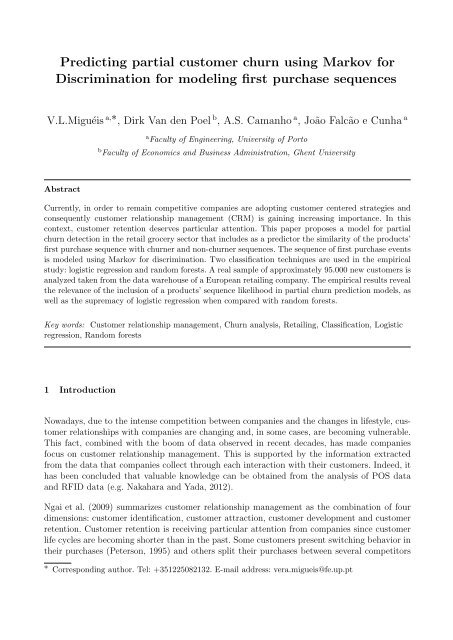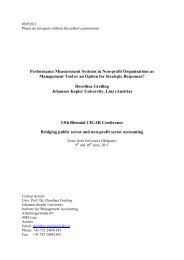Predicting Partial Customer Churn Using Markov for Discrimination ...
Predicting Partial Customer Churn Using Markov for Discrimination ...
Predicting Partial Customer Churn Using Markov for Discrimination ...
You also want an ePaper? Increase the reach of your titles
YUMPU automatically turns print PDFs into web optimized ePapers that Google loves.
<strong>Predicting</strong> partial customer churn using <strong>Markov</strong> <strong>for</strong><br />
<strong>Discrimination</strong> <strong>for</strong> modeling first purchase sequences<br />
V.L.Miguéis a,∗ , Dirk Van den Poel b , A.S. Camanho a , João Falcão e Cunha a<br />
Abstract<br />
a Faculty of Engineering, University of Porto<br />
b Faculty of Economics and Business Administration, Ghent University<br />
Currently, in order to remain competitive companies are adopting customer centered strategies and<br />
consequently customer relationship management (CRM) is gaining increasing importance. In this<br />
context, customer retention deserves particular attention. This paper proposes a model <strong>for</strong> partial<br />
churn detection in the retail grocery sector that includes as a predictor the similarity of the products’<br />
first purchase sequence with churner and non-churner sequences. The sequence of first purchase events<br />
is modeled using <strong>Markov</strong> <strong>for</strong> discrimination. Two classification techniques are used in the empirical<br />
study: logistic regression and random <strong>for</strong>ests. A real sample of approximately 95.000 new customers is<br />
analyzed taken from the data warehouse of a European retailing company. The empirical results reveal<br />
the relevance of the inclusion of a products’ sequence likelihood in partial churn prediction models, as<br />
well as the supremacy of logistic regression when compared with random <strong>for</strong>ests.<br />
Key words: <strong>Customer</strong> relationship management, <strong>Churn</strong> analysis, Retailing, Classification, Logistic<br />
regression, Random <strong>for</strong>ests<br />
1 Introduction<br />
Nowadays, due to the intense competition between companies and the changes in lifestyle, customer<br />
relationships with companies are changing and, in some cases, are becoming vulnerable.<br />
This fact, combined with the boom of data observed in recent decades, has made companies<br />
focus on customer relationship management. This is supported by the in<strong>for</strong>mation extracted<br />
from the data that companies collect through each interaction with their customers. Indeed, it<br />
has been concluded that valuable knowledge can be obtained from the analysis of POS data<br />
and RFID data (e.g. Nakahara and Yada, 2012).<br />
Ngai et al. (2009) summarizes customer relationship management as the combination of four<br />
dimensions: customer identification, customer attraction, customer development and customer<br />
retention. <strong>Customer</strong> retention is receiving particular attention from companies since customer<br />
life cycles are becoming shorter than in the past. Some customers present switching behavior in<br />
their purchases (Peterson, 1995) and others split their purchases between several competitors<br />
∗ Corresponding author. Tel: +351225082132. E-mail address: vera.migueis@fe.up.pt
















